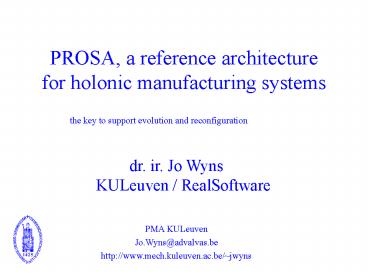PROSA, a reference architecture for holonic manufacturing systems - PowerPoint PPT Presentation
1 / 29
Title:
PROSA, a reference architecture for holonic manufacturing systems
Description:
Direct comparison hierarchical and heterarchical architectures. Objective evaluation ... share common interface and behaviour; idem for order holons and product holons ... – PowerPoint PPT presentation
Number of Views:189
Avg rating:3.0/5.0
Title: PROSA, a reference architecture for holonic manufacturing systems
1
PROSA, a reference architecturefor holonic
manufacturing systems
the key to support evolution and reconfiguration
dr. ir. Jo Wyns KULeuven / RealSoftware PMA
KULeuven Jo.Wyns_at_advalvas.be http//www.mech.kule
uven.ac.be/jwyns
2
Manufacturing control
- logistical planning
- technological planning, late design decisions
- resource allocation
- downloading of NC-programs
- tracking of materials, tools, people, ...
- etc.
gt but broad in space and time
3
Problem statement
- Disturbances
- machine break-down
- rush order
- missing tools
- missing materials
- absenteism
- etc.
- On-line manufacturing control algorithm
- Changes
- new technology
- new markets
- new products
- new organisational structures
- etc.
- Manufacturing control system architecture
4
Reference architecture
Manufacturing control system
System architecture
Reference architecture
HW/SW, implementation
blueprint, components, interactions
style, types of components and interactions
What
execute
abstraction, communication, indicate vital
components
reduce development time, increase quality, unif.
terminology
Goal
building
plans, sketches, specifications
building style, construction elements, ...
Analogy
5
Requirements
Manufacturing control system
System architecture
Reference architecture
low price (build maintain)
reuse of components
decoupling
customised logistical and technological
solutions
generic applicability
predictable operational performance
broad working range (flexible, robust,
availability, ...)
extendable adaptable
self-similarity
6
Evaluation of reference architectures
- Direct comparison hierarchical and heterarchical
architectures - Objective evaluation
- compose list of requirements
- find metrics
- Critique of end-users, developers, researchers,
... - REMARK Paradigm dependency
7
Hierarchical control (ex.)
8
Heterarchical control (ex.)
9
Hierarchical vs. heterarchical control
- Every child node has only 1 parent.
- Master - Slave
- Low Adaptability
- Low support for Evolution
- gt for large systems
- gt not for dynamic systems(changes/disturbances)
- Distributed
- No supervisory control
- Negociation
- No global optimisation
- gt for homogeneous systems
- gt not for large systems
10
Lessons learned
- New approach shall provide
- Dynamic structure
- Decoupling of system structure from control
algorithm - Reactive scheduling and process planning
- Generic applicability
11
Holonic manufacturing systems (HMS)
- Holon
- whole, autonomy
- part, co-operation
- Stability
- decoupling
- self-similar
- Manufacturing holon
12
PROSA basic holons
13
Basic holons
14
Aggregation
- hiding details in aggregated structures
- open-ended at top and bottom
- multiple aggregations (not tree-shaped)
- not static, may change dynamically
- resource, product, order aggregations
15
Aggregation
16
Specialisation
- Different types of resources
- Processing resources, workstations,
- Transport resources, transport system
- ...
- Different types of orders and products
- Stock orders, customer orders
- Different product families
17
Specialisation
18
Staff holons
- Basic holons aggregation specialisation
- only heterarchical control (aggregation contains
no control functionality) - distributed system
- But ...
- centralised problem solving is sometimes easier
(e.g. scheduling) - hierarchical structures in factories
19
Staff holons
- Expert gives advise to the basic holons
- Holonisch manufacturing system
- distributed system robust and adaptable
- ability for centralised functions
- Behaviour hierarchical, heterarchical, and
mengvormen zijn mogelijk
20
Staff holons (3)
21
Flexible assembly system
- Apply PROSA to real machines (robots PLC)
- Switch between real machines and simulation
(virtual factory) - Logistical decisions
- replaceable dynamic market mechanism
- reactive centralised scheduler and schedule
execution
22
Flexible assembly system
23
Example
24
Horizontal self-similarity
- Specialisation uses inheritance (OO)
- All kind of resource holons share common
interface and behaviour idem for order holons
and product holons - gt Special cases/types can be handles similar to
nominal ones - e.g. rush order first-of order high volume vs.
high quality product
25
Vertical self-similarity
- Holarchy is a resource holon on itselfresource
holon can internally be a holarchy - Homogeneity in internal functioning of
holarchies - Resource holon is independent of holarchy to
which it belongs - e.g. belong to multiple holarchies at the same
time (human)
26
Self-similarity (3)
27
Conclusion
- PROSA Product-Resource-Order-Staff Architecture
- necessary basic holons
- optional staff holons
- generalisation of hierarchical and heterarchical
architectures - software framework
28
Conclusion
- Evolution reconfiguration
- decoupling of control algorithm from system
architecture - decoupling of logistical and technological
aspects - self-similarity
29
New opportunities
- On-line technological planning and design
decisions - Hybrid control algorithms
- Self-generating manufacturing control systems
30
More details on PROSA
- Van Brussel, H., J. Wyns, P. Valckenaers, L.
Bongaerts, P. Peeters, (1998) Reference
Architecture for Holonic Manufacturing Systems
PROSA, Computers In Industry, Special Issue on
Intelligent Manufacturing Systems, Vol. 37, No.
3, pp. 255 276. - Wyns, J. (1999), Reference architecture for
holonic manufacturing systems - The key to
support evolution and reconfiguration, Ph.D.
thesis, ISBN 90-5682-164-4, K.U.Leuven. - http//www.mech.kuleuven.ac.be/pma/research/hms
- http//www.mech.kuleuven.ac.be/jwyns
31
Software framework
- Translate reference architecture into software
- Framework
- co-operating abstract classes
- basis for implementing a specific manufacturing
control system - Add classes to support implementation
32
Integration with scheduling
- Planning advise
- what, when, how?
- not invent standard for planning advise
- but design pattern for integration
- Solution multiple decision taking algorithms
one selection algorithm in order holons
33
Integration with scheduling
34
Man-machine interface































